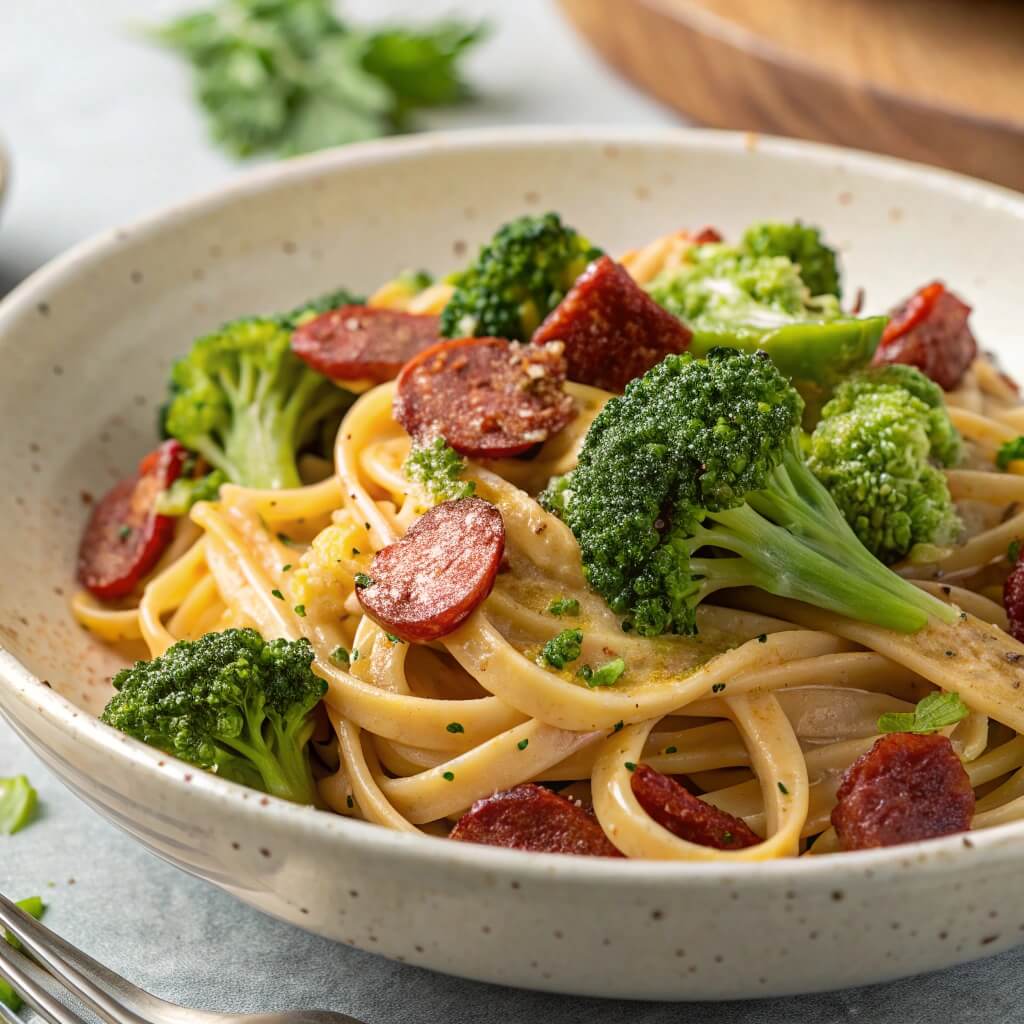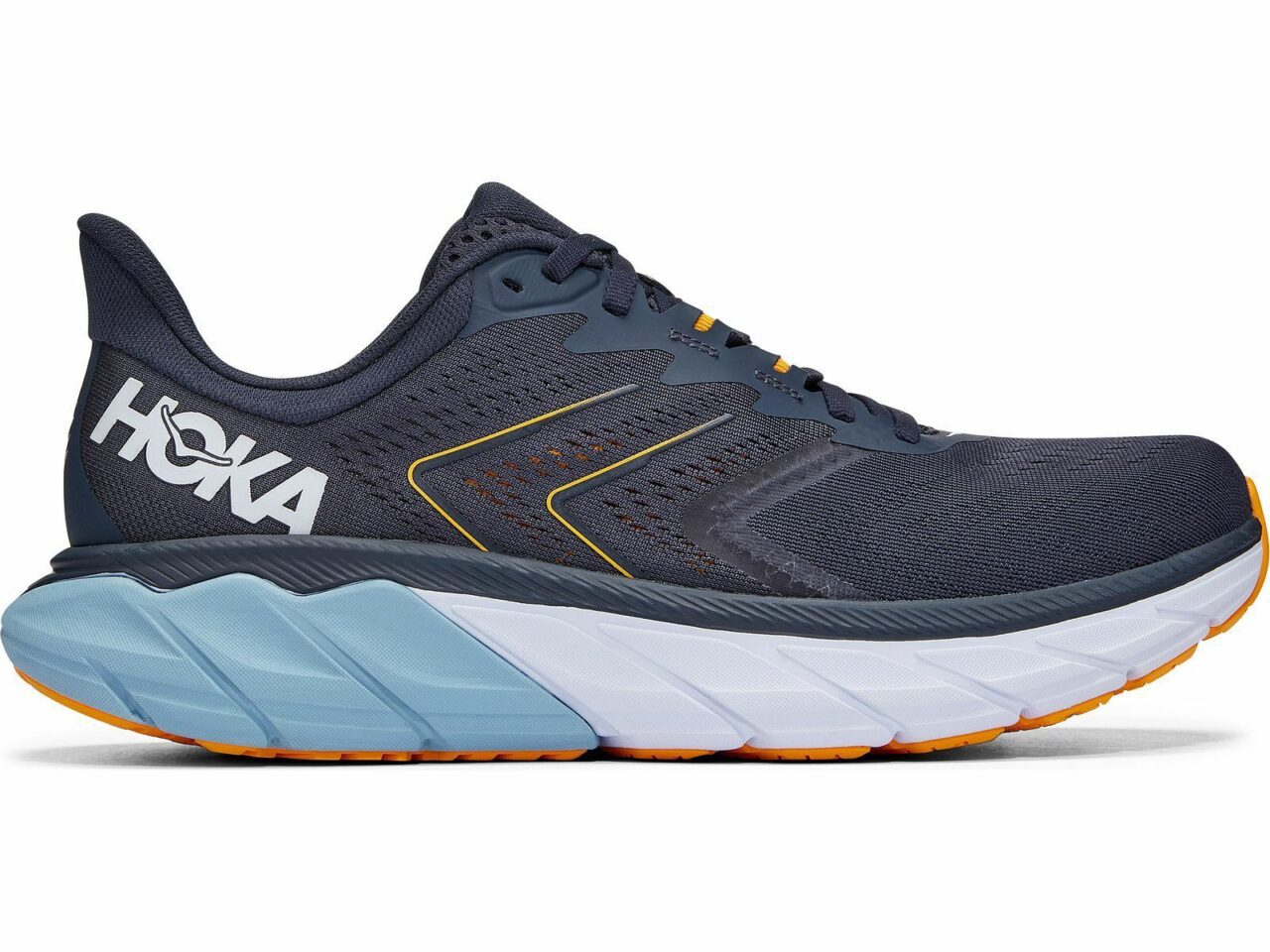What Makes Broccoli and Chorizo Pasta Special?
Broccoli and chorizo pasta combines the smoky heat of Spanish sausage with the earthy freshness of broccoli, all tied together with pasta and a hint of garlic. This combination creates a meal that’s both filling and packed with flavor. The contrast between the spicy chorizo and the mild broccoli makes each bite interesting. At the same time, the pasta serves as the perfect vehicle for absorbing all the flavorful oils released by the chorizo.
People love this dish because it comes together in about 20 minutes, but it tastes like something that took much longer. A friend of mine makes this every Friday night for her family; she calls it her “end of week, no energy” meal, which still feels special. Another home cook I know adds this to his meal prep routine because the flavors improve after a day in the fridge.
Essential Ingredients for Perfect Broccoli and Chorizo Pasta
To make a great broccoli and chorizo pasta, you need just a handful of quality ingredients:
- Pasta: Medium shapes like penne, fusilli, or orecchiette work best as they catch the small bits of chorizo and broccoli
- Chorizo: Spanish-style dried chorizo gives the most flavor, but Mexican fresh chorizo works too
- Broccoli: One medium head, cut into small florets that cook quickly
- Garlic: At least 3-4 cloves, thinly sliced or minced
- Olive oil: A good glug to start the cooking process
- Red pepper flakes: Optional, for extra heat
- Parmesan cheese: Freshly grated for serving
- Salt and pepper: To taste
What makes this dish work so well is how the fat from the chorizo coats the pasta, carrying all those smoky paprika flavors. The broccoli soaks up these same flavors while adding a fresh, green element that balances the richness.
Step-by-Step Cooking Guide to Making Broccoli and Chorizo Pasta
Preparing Your Ingredients
Before you begin cooking, gather all the necessary ingredients and equipment. Cut the broccoli into small, bite-sized florets – they’ll cook faster and mix better with the pasta. Don’t throw away the stems! Peel the tough outer layer and slice the tender insides into thin pieces.
For the chorizo, remove any casing if needed and slice into thin rounds or dice into small chunks. The smaller pieces distribute more evenly throughout the dish, providing flavor in every bite.
Slice your garlic thinly rather than mincing it. This way, you’ll get little bursts of garlic flavor instead of an overwhelming garlic taste throughout.
Cooking Process
- Bring a large pot of heavily salted water to a boil. The water should taste like the sea – this is your only chance to season the pasta itself.
- While waiting for the water to boil, heat a large skillet over medium heat and add a tablespoon of olive oil.
- Add the chorizo to the skillet and cook for about 3-4 minutes, stirring occasionally. You’re looking to render the fat and get the chorizo slightly crispy. The oil in the pan will turn a beautiful orange-red color from the paprika in the chorizo.
- Once the chorizo has rendered its fat, add the sliced garlic and cook for just 30 seconds until fragrant. Be careful not to overcook it, as garlic can turn bitter when cooked too long.
- When your pasta water is boiling, add the pasta and cook for 2 minutes less than the package directions. You want it quite al dente as it will finish cooking in the sauce.
- About 3 minutes before the pasta is done, add the broccoli florets to the same pot. This way, both will finish cooking at the same time, and you’ll save yourself from having to wash another pot.
- Before draining, scoop out about 1 cup of the starchy pasta water. This is liquid gold for your sauce.
- Drain the pasta and broccoli together in a colander, then add them directly to the skillet with the chorizo and garlic.
- Toss everything together over medium heat, adding splashes of the reserved pasta water as needed to create a light sauce. The starch in the water helps bind everything together.
- Taste and add salt and pepper as needed. Remember, chorizo is already salty, so you might need less salt than you think.
Finishing Touches
Once everything is mixed well and heated through, you’re ready to serve. Divide the pasta among warm bowls and top with freshly grated Parmesan cheese. A drizzle of good olive oil at the end adds an incredible richness.
Some people like to add a squeeze of lemon juice over the top for brightness, while others prefer a sprinkle of toasted breadcrumbs for added texture. Both are great options that elevate this simple dish to the next level.
Tips for Enhancing Your Broccoli and Chorizo Pasta
Use the Whole Broccoli
Don’t waste the broccoli stems – they’re packed with flavor and have a nice, tender texture when peeled and sliced thinly. The stems hold up better to the heat than the florets, adding different textures to your dish.
Get the Right Chorizo
Spanish chorizo and Mexican chorizo are very different products. Spanish chorizo is dried and cured, ready to eat as is, whereas Mexican chorizo is fresh and needs to be cooked through, similar to ground meat. Both work in this recipe, but they give different results:
- Spanish chorizo: Gives a more intense, smoky flavor and creates a beautiful red oil
- Mexican chorizo: Creates a more meat-sauce-like texture as it crumbles when cooked
Try both types to see which you prefer. Some home cooks even use half of each for the best of both worlds.
Pasta Choice Matters
Short pasta shapes are ideal for this dish because they blend well with the small pieces of broccoli and chorizo. Here are some good options:
- Orecchiette: The little “ears” catch bits of chorizo
- Fusilli: The spirals trap the flavorful oil
- Penne: The hollow centers fill with the sauce
- Farfalle: The bow-tie shape adds visual interest
Avoid long pasta, such as spaghetti or linguine, as the chorizo and broccoli tend to fall to the bottom of the plate rather than mix well with each strand.
Make It Creamier
For a richer version, add a splash of heavy cream or a dollop of crème fraîche at the end of cooking. Just a little dairy helps round out the flavors and creates a silky sauce that coats every bite.
Nutritional Benefits of This Hearty Meal
Broccoli and chorizo pasta offers more than just great taste – it also provides a good balance of nutrients. Let’s break down what you’re getting:
Broccoli: A Nutritional Powerhouse
Broccoli brings profound health benefits to this dish:
- Vitamin C: One serving contains more vitamin C than an orange
- Fiber: Helps keep you full and aids digestion
- Vitamin K: Important for bone health and blood clotting
- Antioxidants: Help fight inflammation and support your immune system
The way you cook broccoli affects its nutrition. The quick blanching method used in this recipe preserves more nutrients than long cooking times. The bright green color of properly cooked broccoli isn’t just visually appealing – it’s a sign that you’ve retained more of the beneficial nutrients intact.
Protein Balance
Chorizo adds protein to the meal, making it more filling and satisfying. While chorizo is higher in fat than some other protein sources, the small amount used in this recipe adds tons of flavor without making the dish too heavy.
The pasta itself also provides some protein, especially if you choose a whole-grain variety. For an even bigger protein boost, some cooks add a can of white beans or chickpeas to the mix.
Carbohydrate Considerations
The pasta provides carbohydrates that give you energy. If you’re watching your carb intake, you can:
- Use less pasta and more broccoli
- Choose whole wheat pasta for more fiber
- Try a legume-based pasta made from chickpeas or lentils
Remember that the starchy pasta water you save serves an essential purpose – it helps create a sauce without adding extra fat.
Common Mistakes to Avoid When Cooking Broccoli and Chorizo Pasta
Overcooking the Broccoli
The most common mistake people make is overcooking the broccoli. When broccoli turns mushy and dull olive-green, it loses both texture and nutrients. For best results:
- Keep the florets bite-sized but not too small
- Add them to the pasta water just 3 minutes before the pasta is done
- They should be tender-crisp when you drain them
- Remember, they’ll cook a bit more when mixed with the hot chorizo and pasta
Properly cooked broccoli adds a pleasant texture contrast to the softer pasta and chewy chorizo bits.
Using Too Much or Too Little Chorizo
Finding the right balance with chorizo can be tricky. Too much makes the dish greasy and overwhelms the broccoli. Too little means you miss out on that signature flavor.
For a standard package of pasta (about 1 pound dry), use about 4-6 ounces of chorizo. This provides plenty of flavor without making the dish too heavy or fatty.
If you’re using fresh Mexican chorizo, which is fattier, you might want to drain some of the rendered fat before adding the garlic and other ingredients.
Not Saving Pasta Water
Many home cooks drain their pasta and immediately rinse it with cold water. This is a big mistake for several reasons:
- You lose the starchy water that helps create your sauce
- Rinsing washes away surface starch that helps sauce stick to pasta
- You cool down the pasta, making it harder to absorb flavors
Always remember to set aside at least a cup of pasta water before draining. Even if you don’t use it all, it’s better to have it on hand than to wish you had saved some.
Skipping the Rest Period
Once you’ve combined all the ingredients, let the dish rest for a minute or two before serving. This brief pause allows the flavors to meld together and the sauce to thicken slightly as it cools. The pasta will also absorb more flavor during this time.
Just cover the skillet and turn off the heat for 1-2 minutes before plating. This small step makes a noticeable difference in the final taste.
Using Low-Quality Ingredients
Since this recipe has relatively few ingredients, the quality of each one is more important. Critical Pay special attention to:
- Chorizo quality: Look for chorizo made with good pork and authentic spices. The better the chorizo, the better the final dish will be.
- Olive oil: Use a high-quality extra-virgin olive oil, especially for the final drizzle.
- Parmesan: Freshly grated tastes much better than pre-grated options, which often contain anti-caking agents.
- Pasta: Bronze-die extruded pasta has a rougher surface that holds sauce better.
You don’t need the most expensive ingredients, but choosing good quality basics will elevate your meal from good to great.
Why This Dish Deserves a Regular Spot in Your Meal Rotation
Broccoli and chorizo pasta earns its place in your regular cooking lineup because it strikes that perfect balance between ease and satisfaction. It’s quick enough for busy weeknights but tasty enough to serve to friends without apology. The combination of spicy chorizo and fresh broccoli creates a flavor contrast that keeps your taste buds interested bite after bite.
This dish also shows how simple cooking techniques can transform basic ingredients into something special. The way the chorizo fat coats the pasta, how the broccoli soaks up the garlicky oil, and the way the pasta water creates a light sauce – these are all examples of sound cooking principles that you can apply to other dishes too.
Another reason to love this recipe is its flexibility. Once you understand the basic technique, you can swap ingredients based on what’s in season or what you have on hand:
- No broccoli? Try kale, spinach, or asparagus
- Out of chorizo? Pancetta or bacon can stand in
- Want more protein? Add shrimp or white beans
- Need it vegetarian? Use smoked paprika and olive oil instead of chorizo
The core technique stays the same, making this a template for countless variations rather than just a single recipe.
Finally, this dish represents what good home cooking is all about – taking a few quality ingredients and treating them with care to create something more than the sum of its parts. It’s the kind of cooking that doesn’t require special equipment or hard-to-find ingredients, just a little care and attention to detail.
Next time you’re standing in front of your pantry wondering what to make for dinner, remember this simple combination. As long as you have pasta, some green vegetables, and a flavorful protein, you’re well on your way to a satisfying meal that comes together with minimal effort but maximal flavor.











